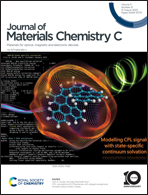Non-linear photo-switching in molecular actuators through intra-molecular energy transfer from an electron donating core†
Abstract
We present a new design for multi-chromophoric molecules where the non-linear absorption properties of a central electron-donating core are used to confer indirect biphotonic absorption features to molecular actuators. This design allows for a general way to provide two-photon reactivity to molecular systems which, by themselves, could not be controlled by a non-linear optical input. The compounds are based on a two-photon-active N,N′-1,4-dihydropyrrolo[3,2-b]pyrrole central unit. This core is symmetrically substituted at the ends of its long axis by nitrophenyl groups defining a pseudo-centrosymmetric acceptor–donor–acceptor (A–D–A) antenna-unit. For this first proof-of-concept study, azo-isomerizable actuators were bonded to the central unit through the nitrogen atoms of the heterocyclic core. This design allows for the pyrrolo-pyrrole chromophore to act as a non-linear absorbing unit, so that E–Z isomerization of the actuators can be induced after excitation into higher states localized at the central unit, followed by energy transfer into acceptor-localized excited states. The non-linear isomerization of the actuators was observed using pulsed NIR light from a Ti:Sapphire laser in a setup that allows for significant accumulation of the actuator-isomerized product in macroscopic samples. We demonstrate that the two-photon photochemistry of the actuators is due to the coupling with the central core unit since models of the azo-actuator compounds alone do not undergo these transformations at the same irradiation levels. Time-resolved emission studies indicate that the population associated with higher core-centered 1ππ* states evolve towards actuator-localized in a time-scale of picoseconds. These signals and the overall photochemistry are consistent with a mechanism where the formation of the actuator-localized 1nπ* states is directly followed by the azo-isomerization reactions. Computational studies at the TD-DFT level of theory, together with the use of a quadratic response method were used to characterize the states responsible for the two-photon absorption properties. This kind of molecular assembly can be extended to induce non-linear photochemistry in other types of actuators, including dissociative systems or uncaging ligands, or to induce catalytic activity in highly localized environments.



 Please wait while we load your content...
Please wait while we load your content...